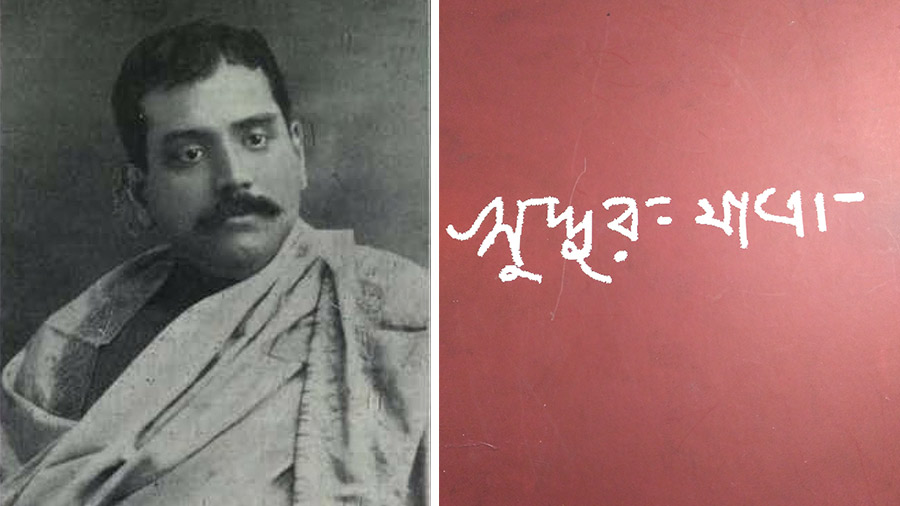Surpanakha in high-heeled shoes, Hanuman piloting an aeroplane to Lanka — seems like an OTT take on Ramayan? Wrong, these are snippets from Khuddur Jatra — a contemporary look at the epic by Abanindranath Tagore, more than six decades ago.
This masterpiece was unfortunately never published. The manuscript had been gathering dust till excerpts were published in a Kala Bhavana journal in 2006. Three years later, the entire book was finally published by Pratikshan, in what turned out to be a collector’s edition.
On Abanindranath Tagore’s birth anniversary, My Kolkata takes a look back at what was perhaps one of his greatest works.
Man of many parts
A master artist who dabbled in many forms, a storyteller par excellence with an unforgettable contribution to children’s literature — Abanindranath Tagore had many talents.
Buro Angla, Khirer Putul, Nalok and Rajkahini are among his much-loved works in Bengali literature. But Khuddur Jatra opens up a completely new dimension to his work. It’s a unique concurrence of text and visual inputs.
It is one of the several jatra palas (a theatrical form that has its roots in eastern India) that Abanindranath wrote between 1933 and 1943. Many of these puthipalas (jatra scripts) were based on Ramayan and were published in magazines — Marutir Punthi was published in Mouchak, Chhai-Burir Punthi was published in Mouchak as Pora-Lonkar Punthi and Mahabirer Punthi was published in Rangmashal magazine.
The birth of ‘Khuddur Jatra’
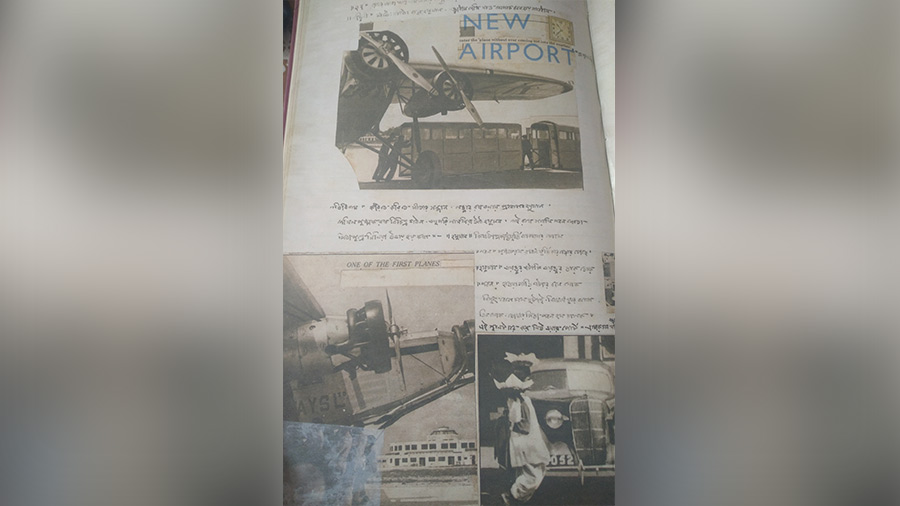
Hanuman flies to Lanka in a ‘hawagadi’ or aeroplane labelled ‘New Airport’ From Khuddur Jatra
The 10 years — 1933 to 1943 — that Abanindranath Tagore worked on Khuddur Jatra was a significant time that witnessed many historical events; the most important being the Second World War (1939-1945). The Swadeshi movement was on in full swing around this time and in 1930, Mahatma Gandhi led the Dandi March.
This was the background in which Abanindranath started writing Khuddur Jatra. Abanindranath’s grandson, Mohanlal Ganguly, in his book Dakhiner Baranda, had mentioned that Abanindranath had a friend from Art Society, an Englishman named Mr. Benthol, whose son visited Jorasanko. Abanindranath wanted to show him a jatrapala and with that in mind, he got hold of a copy of Krittibasi Ramayan and started writing the different acts. Khuddur Jatra is one of them. He also experimented with songs, an integral part of jatrapala.
Abanindranath Tagore also created kutum katam — figures made from anything and everything available at hand, like broken glass, cellophane paper, branches of trees — during this time. It was his quest to find something new, to find a spirit of fun in art. Though regarded as toys by many, including Rabindranath Tagore, the figures of kutum katam were the first in assemblage sculpture — made with found objects and assembled.
From a revivalist to a postmodern artist
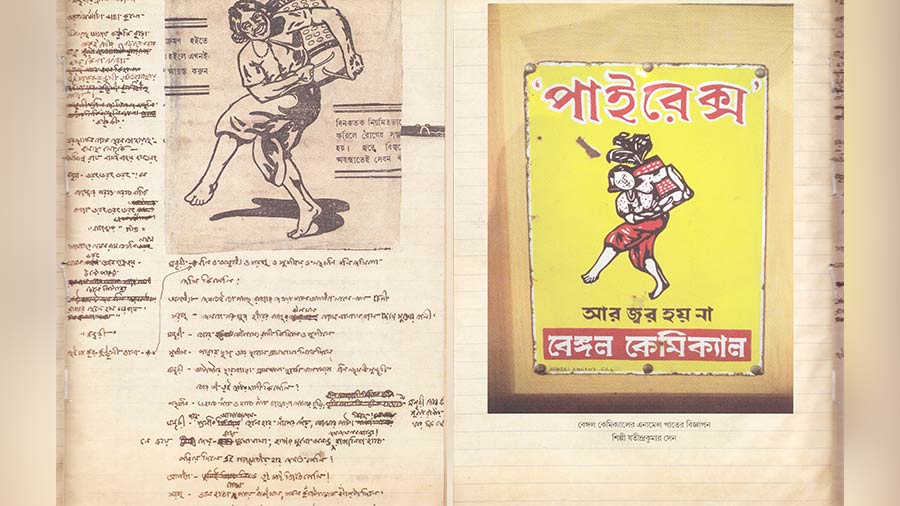
The Pirex advertisement drawing of Bengal Chemicals by Jatindra Kumar Sen is pasted on page six when the people of Ayodhya celebrate the birth of Ram and his brothers From Khuddur Jatra
Abanindranath was regarded as a master of the Bengal School of Art that emerged at the beginning of the 20th century. But Khuddur Jatra proves that he was much more than that. It was a new unravelling of his genius that opened up another facet of his creativity, that of a post-modernist artist.
“The context, decontext, visual appropriation and collages he presented in Khuddur Jatra make him a post-modern artist. Abanindranath Tagore demonstrated how a single visual can have multiple meanings and can be put to use,” said Debdutta Gupta, assistant professor at St. Xavier's College, who not only transcribed the text, but also researched the context and decontext of the images of the same.
From the racks
Khuddur Jatra or Khudi Ramleela was different from the other palas like Joyramer Punthi or Mariker Punthi that Abanindranath wrote. It was the illustrations that set it apart.
All the other palas (musical plays) were published, but Khuddur Jatra remained on the shelves.
References to Khuddur Jatra can be found in the writings of many, including poet and essayist Sankha Ghosh’s Kalponar Hysteria. Ghosh, Satyajit Ray and Purnendu Patri were among those who had seen the large-sized original manuscript, which remained with Sumitendranath Tagore or Badshah Thakur, grandson of Abanindranath Tagore, for almost 70 years.
Portions of Khuddur Jatra with images were published in Nandan Patrika, a journal of Kala Bhavana in 2006. It was only in 2009 that Pratikshan managed to release the entire book.
The book has two volumes — the first contains the manuscript in a facsimile edition and the second contains supplementary additions of the responses of Sankha Ghosh, artist Ramananda Bandopadhyay and art historian R. Siva Kumar.
“When the artist selects and organises pictures of men and events from books and newspapers from the West to go with the account of the war preparations by Ram and Ravan and incorporates pictures from Africa, then the Khuddi Ramayan steps beyond the Ramayan narrative to capture traces of our own times at the level of the state and our everyday society alike,” Ghosh wrote in his essay in the second volume.
A Herculean task
The volume also has a transcripted reading in Bengali by Debdutta Gupta and a shortened English translation by Samik Bandyopadhyay.
Publishing the book had proved to be a Herculean task. The manuscript was damaged in many places, making the writings nearly illegible.
Gupta took on the mammoth job of deciphering the writings and copying it. “There were places where only a portion of the text could be read. To understand the word, the lines before it and after it were taken as reference and then put to words,” Gupta said.
Gupta also started putting the work in context so that the use of the various advertisement clippings and other images became clear.
The Bengal Nagpur Railways advertisement published in Four Arts journal finds a place in Khuddur Jatra when Ram and Lakshman set out to find Sita. The image of a dancing girl under which the title of the book appears is drawn by artist Jaya Appasami and published by Visva-Bharati News in 1936.
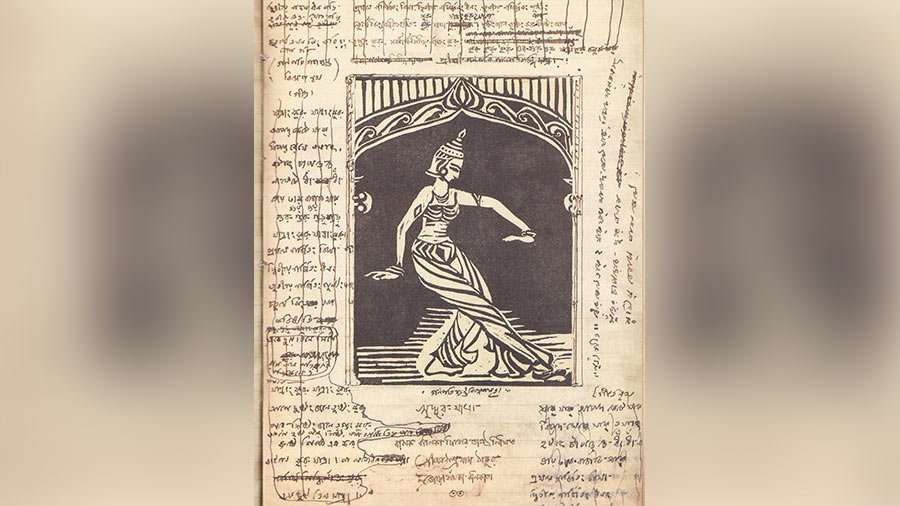
The image of a dancing girl under which the title of the book appears is drawn by artist Jaya Appasami From Khuddur Jatra
The Eagle brand label that appears on the first page is turned around and pasted to give it a new context of a masthead. At the bottom of the page, a portion of the text is erased and turned into a doodled Ganpati.
The Pirex advertisement drawing of Bengal Chemicals by Jatindra Kumar Sen, who wrote under the name Jajati, is pasted on page six when the people of Ayodhya celebrate the birth of Ram and his brothers by singing and dancing.
In the beginning of Lanka Kando, Abanindranath used advertisement cuttings from PM Bagchi Panjika. It also stands as a classic example of an art book.
A look inside
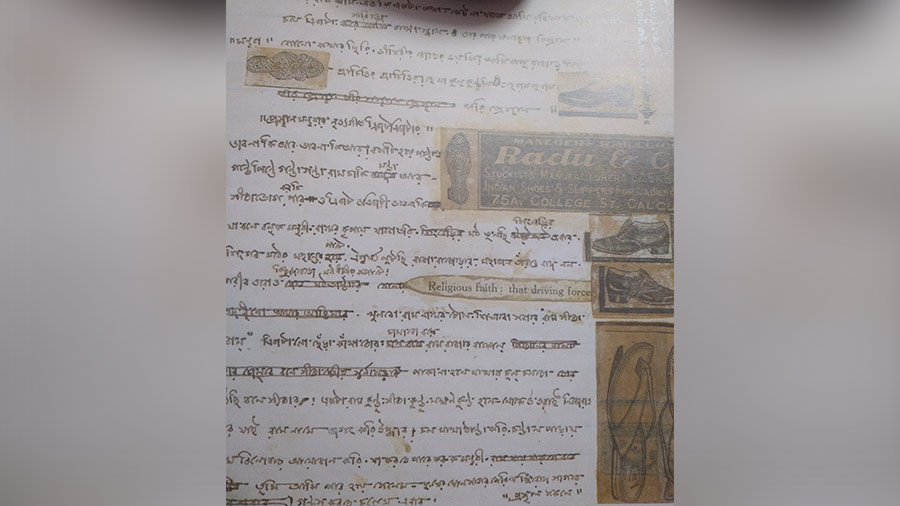
When Bharat returns to Ayodhya with Ram’s paduka, an insertion of a Radu shoes advertisement from a newspaper is noted From Khuddur Jatra
Khuddur Jatra is a retelling of Ramayan in contemporary style. He created characters named Bidhiram Sharma, Khudiram, Becharam and Kenaram who retells the entire story.
The illustrations done are mostly collages of images cut out from different magazines, periodicals, newspaper, posters and labels — creating a visual representation of contemporary styles. It's a brilliant melange of illustration — be it doodles, diagrams, graphical representations and every other modern form.
The entire jatra pala is a reflection of the public and private habits of people, especially the elite. It is not only a retelling of Ramayan but also offers an insight into life.
In Khuddur Jatra, the characters of Ramayan interact with the present time. For example, Surpanakha is seen wearing high-heeled chappals, Hanuman flies to Lanka in a hawagadi or aeroplane labelled ‘New Airport’.
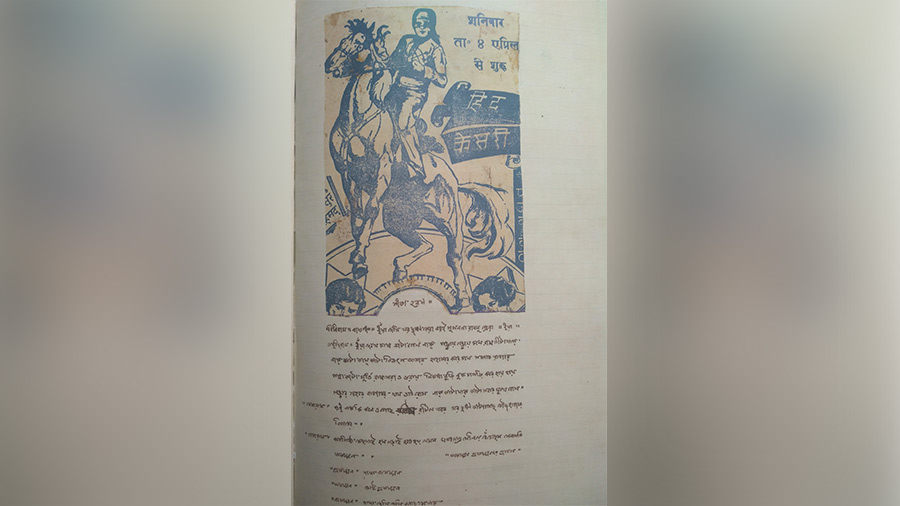
When Ravan steals Sita, a poster of the Hindi movie 'Hind Kesari' showing Bahadur on horseback with a couple of women’s faces underneath is used From Khuddur Jatra
When Bharat returns to Ayodhya with Ram’s paduka, an insertion of a Radu shoes advertisement from a newspaper is noted. When Ravan steals Sita, a poster of the Hindi movie Hind Kesari showing Bahadur on horseback with a couple of women’s faces underneath is used. A cutting of Mickey Mouse, Minnie Mouse and Pluto is pasted as an illustration for the dancing and singing of Sugrib and other monkeys at the sight of Ram and Lakshman.
